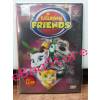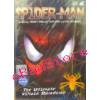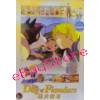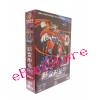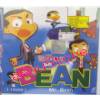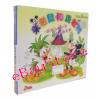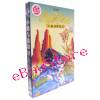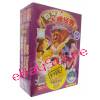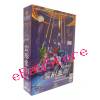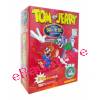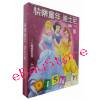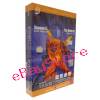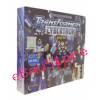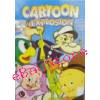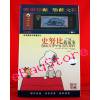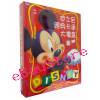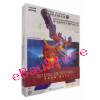
15Dec2025 - 03:27 05 AM
English Anime
tom and jerry 100 years of disney
Code : 9854677550945
| Price : | |
| Weight : | 200 g |
| Genre : | Boy Series Animation , |
| Subtitle : | English , |
| Language : | Cantonese , Chinese/ Mandarin , English , |
| Video Format : | NTSC , |
| Discs : | 3 |
| Region Code : | ALL , |
| Model : | DVD9 , |
The plots of each short usually center on Tom's frustrated attempts to catch Jerry, and the mayhem and destruction that ensues. Since Tom rarely attempts to eat Jerry and because the pair actually seem to get along in some cartoon shorts (at least in the first minute or so), it is unclear why Tom chases Jerry so much. But some reasons given may include normal feline/murine enmity, duty according to his owner, Jerry's attempt at ruining a task that Tom is entrusted with, revenge, Jerry saving other potential prey (such as ducks, canaries, or goldfish) from being eaten by Tom, or competition with another cat, among other reasons.
Tom rarely succeeds in catching Jerry, mainly because of Jerry's cleverness and cunning abilities, but sometimes because of Tom's own stupidity. Tom sometimes beats Jerry, usually when Jerry becomes the instigator or when he crosses some sort of line.
The shorts are famous for some of the most violent gags ever devised in theatrical animation: Jerry slicing Tom in half, shutting his head in a window or a door, Tom using everything from axes, pistols, explosives, traps and poison to try to murder Jerry, Jerry stuffing Tom's tail in a waffle iron, kicking him into a refrigerator, plugging his tail into an electric socket, pounding him with a mace, club or mallet, causing a tree to drive him into the ground and so on. Despite the frequent violence, there is no blood or gore in any scenes. A recurring gag involves Jerry hitting Tom when he's preoccupied, with Tom initially oblivious to the pain - and only feeling the effects moments later, and vice versa; and another involves Jerry stopping Tom in midchase (as if calling for a time-out), before he does something, usually putting the hurt on Tom.
The cartoon is also noteworthy for its reliance on stereotypes, such as the blackening of characters following explosions and the use of heavy and enlarged shadows (e.g., Dr. Jekyll and Mr. Mouse). Resemblance to everyday objects and occurrences is arguably the main appeal of visual humor in the series. The characters themselves regularly transform into ridiculous but strongly associative shapes, most of the time involuntarily, in masked but gruesome ways (see also Cartoon physics).
Music plays a very important part in the shorts, emphasizing the action, filling in for traditional sound effects, and lending emotion to the scenes. Musical director Scott Bradley created complex scores that combined elements of jazz, classical, and pop music; Bradley often reprised contemporary pop songs, as well as songs from MGM films, including The Wizard of Oz and Meet Me In St. Louis. Generally, there is no dialogue in Tom or Jerry, apart from the occasional few lines in certain moments. The character, Mammy Two Shoes, has lines in every episode. Most of the dialogue from Tom and Jerry are the high-pitched laughs and gasping screams, which may be provided by a horn or other musical instrument.
Before 1954, all Tom and Jerry cartoons were produced in the standard Academy ratio and format; from late 1954 to 1955, some of the output was dually produced in both Academy format and the widescreen CinemaScope process. From 1956 until the close of the MGM cartoon studio a year later, all Tom and Jerry cartoons were produced in CinemaScope, some even had their soundtracks recorded in Perspecta Stereo. The 1960s Gene Deitch and Chuck Jones shorts were all produced in Academy format, but with compositions that made them compatible to be matted to Academy widescreen format as well. All of the Hanna and Barbera cartoons were produced in three-strip Technicolor, the 1960s entries were done in Metrocolor.
Tom rarely succeeds in catching Jerry, mainly because of Jerry's cleverness and cunning abilities, but sometimes because of Tom's own stupidity. Tom sometimes beats Jerry, usually when Jerry becomes the instigator or when he crosses some sort of line.
The shorts are famous for some of the most violent gags ever devised in theatrical animation: Jerry slicing Tom in half, shutting his head in a window or a door, Tom using everything from axes, pistols, explosives, traps and poison to try to murder Jerry, Jerry stuffing Tom's tail in a waffle iron, kicking him into a refrigerator, plugging his tail into an electric socket, pounding him with a mace, club or mallet, causing a tree to drive him into the ground and so on. Despite the frequent violence, there is no blood or gore in any scenes. A recurring gag involves Jerry hitting Tom when he's preoccupied, with Tom initially oblivious to the pain - and only feeling the effects moments later, and vice versa; and another involves Jerry stopping Tom in midchase (as if calling for a time-out), before he does something, usually putting the hurt on Tom.
The cartoon is also noteworthy for its reliance on stereotypes, such as the blackening of characters following explosions and the use of heavy and enlarged shadows (e.g., Dr. Jekyll and Mr. Mouse). Resemblance to everyday objects and occurrences is arguably the main appeal of visual humor in the series. The characters themselves regularly transform into ridiculous but strongly associative shapes, most of the time involuntarily, in masked but gruesome ways (see also Cartoon physics).
Music plays a very important part in the shorts, emphasizing the action, filling in for traditional sound effects, and lending emotion to the scenes. Musical director Scott Bradley created complex scores that combined elements of jazz, classical, and pop music; Bradley often reprised contemporary pop songs, as well as songs from MGM films, including The Wizard of Oz and Meet Me In St. Louis. Generally, there is no dialogue in Tom or Jerry, apart from the occasional few lines in certain moments. The character, Mammy Two Shoes, has lines in every episode. Most of the dialogue from Tom and Jerry are the high-pitched laughs and gasping screams, which may be provided by a horn or other musical instrument.
Before 1954, all Tom and Jerry cartoons were produced in the standard Academy ratio and format; from late 1954 to 1955, some of the output was dually produced in both Academy format and the widescreen CinemaScope process. From 1956 until the close of the MGM cartoon studio a year later, all Tom and Jerry cartoons were produced in CinemaScope, some even had their soundtracks recorded in Perspecta Stereo. The 1960s Gene Deitch and Chuck Jones shorts were all produced in Academy format, but with compositions that made them compatible to be matted to Academy widescreen format as well. All of the Hanna and Barbera cartoons were produced in three-strip Technicolor, the 1960s entries were done in Metrocolor.



